Towards a deeper understanding of senior tourists: challenges and opportunities of an emerging market segment
Main Article Content
Abstract
The world’s population is ageing with virtually every country in the world experiencing growth in the number and proportion of older people in the population (United Nations, 2015). The number of over 60s has risen by a third over the last decade, making this the fastest growing consumer segment (Euromonitor, 2017). This fast growth of the ageing population is set to become a major lead market for many and various sectors and makes this group a segment not to be overlooked. The market for senior tourists already represents a key economic segment. It has drawn increasing attention from researchers in the past decade (Patterson, 2006), with a growing recognition that they place travel and tourism high on the list of their priorities when they retire (Statts and Pierfelice, 2003; Balderas-Cejudo et al., 2016). Nevertheless, the travel industry has been criticized for failing to recognize the diversity of travel preferences required to attract, connect and market to seniors. This article provides an analysis of the literature on the socio- demographics of seniors, discusses different trends and shifts in their leisure behaviour, and draws implications for the tourism and hospitality industry. The literature presented in this review was identified through multiple sources including the use of a range of tourism databases and tracking citations from the research literature. This paper aims to review these issues within the tourism and population ageing literature to ascertain (1) shifting trends in silver travelers and (2) how tourism providers need to respond to seniors changing needs and wants.
Keywords: Seniors, tourism, hospitality, ageing, market segment.
Downloads
Article Details
Copyright Notices Proposed by Creative Commons
Proposed policy for journals offering deferred open access
Those authors who have publications with this journal, accept the following terms:
1. The authors will retain their copyright and guarantee to the journal the right of first publication of their work, which will be simultaneously subject to the Creative Commons Recognition License CC BY-NC 4.0 (Creative Commons — Attribution-NonCommercial 4.0 International — CC BY-NC 4.0 ) hird parties to share the work provided that its author and its first publication is indicated this journal and no commercial use is made.
2. Authors may adopt other non-exclusive licensing agreements for the distribution of the published version of the work (e.g., deposit it in an institutional telematics file or publish it in a monographic volume) provided that the initial publication is indicated in this journal.
3. Authors are allowed and recommended to disseminate their work over the Internet (e.g. in institutional telematics files or on their website) before and during the submission process, which can produce interesting exchanges and increase citations of the published work. (See The effect of open access: http://opcit.eprints.org/oacitation-biblio.html.
